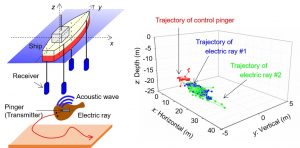News
Demonstration of seabed exploration using electric rays
A research group of Dr. Yo Tanaka (Group B01, RIKEN) has completed a feasibility study indicating that electric rays and sting rays equipped with pingers will be able to map the seabed through natural exploration.

The ocean is a big place full of natural resources including fossil fuels, minerals, and of course, fish. The problem is that many of these resources are on the ocean floor in places we have yet to find. Ocean exploration is therefore necessary, and currently automated vehicles, sonar, and satellites are all used with varying advantages and disadvantages. The team is developing a completely different system that relies on the natural swimming behavior of electric rays.
For the first step to realize this concept, the detail behavior of the benthic rays must be analyzed. In this study, the team used a system with a large water tank (10 m×5 m×6 m height) to measure the movement patterns of the benthic rays. The team confirmed that it was feasible to optically trace the 2D and 3D movement of a sting and an electric ray and that the speed of the rays indicated whether they were skimming slowly over the bottom surface or swimming.
Then, the team investigated feasibility for measuring the sea bottom features using two electric rays equipped with small pingers (acoustic transmitters) and receivers on a boat. We confirmed tracing of the movements of the rays over the sea bottom for more than 90 min at 1 s time resolution. Since the team can know whether rays are skimming slowly over the bottom surface or swimming in water from the speed, this would be applicable to mapping the sea bottom depth. This is the first step to investigate the feasibility of mapping the seabed using a benthic creature. This is also important achievement for “soft robotics” as it uses intelligence and power source of creatures for useful work.
The study was published in SN Applied Sciences on December 9th.
Paper title: Movement tracing and analysis of benthic sting ray (Dasyatis akajei) and electric ray (Narke japonica) toward seabed exploration
Link to the paper: https://doi.org/10.1007/s42452-020-03967-6
